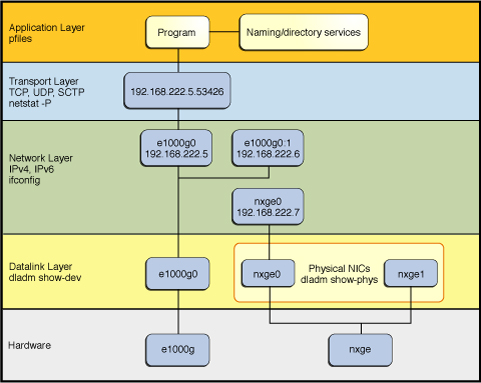Comparing the Oracle Solaris 10 Network Protocol Stack to the Oracle Solaris 11 Network Protocol Stack
In previous Oracle Solaris implementations of the network protocol stack, interfaces and links on the software layer were built on the devices in the hardware layer. More specifically, a hardware device instance in the hardware layer had a corresponding link on the datalink layer and a configured interface on the interface layer. This one-to-one relationship amongst the network device, its datalink, and its IP interface is illustrated in the following figure.
Figure 7-1 Oracle Solaris 10 Network Protocol Stack With Network Devices, Links, and Interfaces Displayed

-
The one-to-one relationship that binds the device, the datalink, and the interface means that the network configuration is dependent on the hardware configuration and also the network topology. Thus, interfaces must be reconfigured if changes are implemented in the hardware layer, such as replacing the NIC or changing the network topology.
-
There is limited support for virtual devices at the datalink layer. Only link aggregations are supported in Oracle Solaris 10.
-
The ifconfig command manages logical interface names, where each logical interface corresponds to an IP address on the interface. It is not always obvious which managed features apply to the interface and which apply to individual addresses.
The Oracle Solaris 10 implementation has the following limitations:
In Oracle Solaris 11, the one-to-one relationship between the hardware, datalink, and interface layers remains, as shown in the following figure. However, the software layer is decoupled from the hardware layer. With this separation, network configuration on the software layer is no longer bound to the chipset or the network topology in the hardware layer.
Figure 7-2 Oracle Solaris 11 Network Protocol Stack With Devices, Links, and Interfaces Displayed

-
The network configuration is insulated from any changes that might occur in the hardware layer. Link and interface configurations are preserved even if the underlying hardware is removed. These same configurations can then be reapplied to any replacement NIC, provided that the two NICs are of the same type.
-
The separation of the network configuration from the network hardware configuration also enables the use of customized link names in the datalink layer.
-
With the abstraction of the datalink layer, multiple networking abstractions or configurations, such as virtual local area networks (VLANs), virtual network interface cards (VNICs), physical devices, link aggregations, and IP tunnels are unified into a common administrative entity, which is the datalink.
The changes that are implemented in Oracle Solaris 11 make network administration more flexible in the following ways:
For more information about how networking features are administered within the Oracle Solaris network protocol stack, see Network Administration Within the Oracle Solaris Network Protocol Stack in Strategies for Network Administration in Oracle Solaris 11.2 .